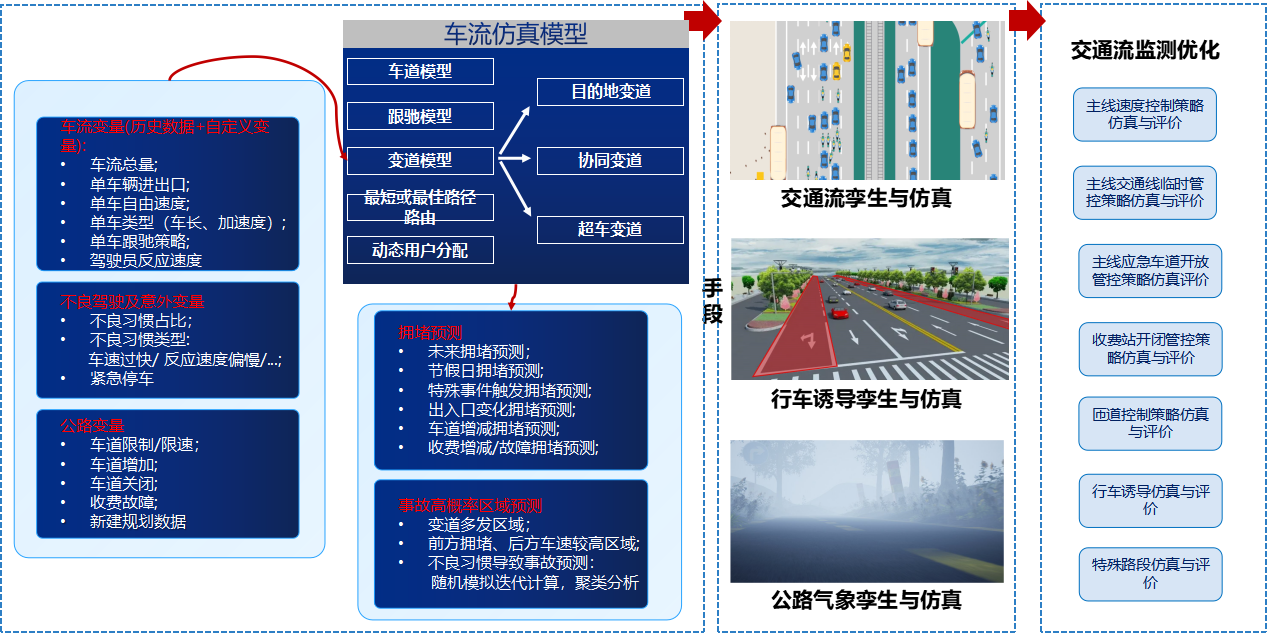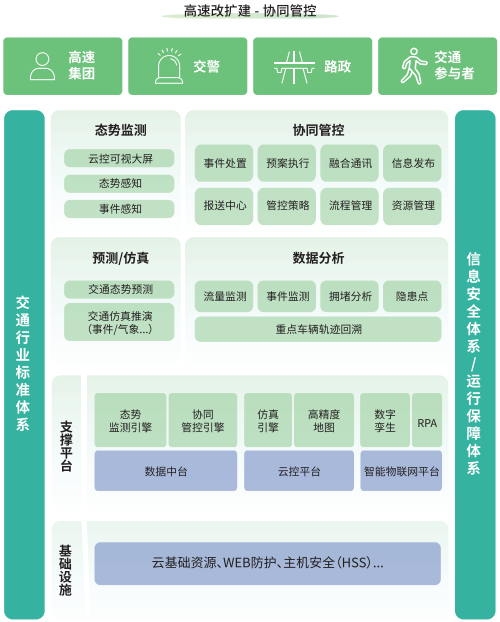Smart Expressway Collaborative Management and Control Platform Solution
-

Fields of Application
Expressway
-

Solution Overview
The smart expressway collaborative management and control platform uses advanced wireless communication and new-generation Internet and other technologies to gather expressway information resources. It enables expressway traffic operation monitoring and early warning, operation coordination and command, video image analysis, and comprehensive information processing. The platform supports comprehensive scientific decision-making for the government, expressway managers, and operation and maintenance personnel, provides comprehensive operation management for enterprises, and offers comprehensive traffic information services for citizens. The platform enhances the safety guarantee capabilities of expressways, minimizes potential accident risks, reduces the severity of accidents, ensures all-weather access to expressways, guarantees traffic safety, improves traffic efficiency, and builds a safe, efficient, and environmentally friendly traffic system.
-

Solution Highlights
- Situation Awareness
The platform's awareness fusion analysis engine includes five parts: a cloud-controlled visual large-screen service engine, an integrated service engine for road network situations, a data analysis engine, an intelligent situation awareness engine, and a traffic situation prediction engine. Among them, the cloud-controlled visual large-screen service engine provides data interfaces for the visual display of the overall road, infrastructure, operation monitoring, toll management, electromechanical operation and maintenance status, road property management, maintenance management, production control, traffic meteorology, etc. These interfaces are presented in a data-driven business state to empower and guide business management decision-making.
- Collaborative Management and Control
For scenarios such as road sections with driving risks, heavy traffic, adverse weather, and traffic accidents, the platform integrates high-precision maps and positioning systems, roadside radar, and video technologies to monitor road traffic facilities and their operational conditions. It evaluates traffic flow for each lane of the expressway and develops tailored traffic management and control schemes based on the traffic conditions and specific needs of each lane. Expressway management personnel can control, regulate, and guide lane traffic flow using equipment such as signal systems, variable information signs, and VICS equipment.
- Traffic Simulation
Using technologies like data mining and traffic simulation, the platform dynamically develops control strategies to replace traditional customized automatic control programs or manual management decisions. It implements daily collaborative control based on traffic patterns and active collaborative control based on traffic events, thereby enhancing traffic safety and optimizing road utilization.

- RPA Process Robot Operation
Given the characteristics of daily expressway operations and reporting processes, the RPA (Robotic Process Automation) robot replaces manual tasks with automated operations. It assists staff in handling large, repetitive, and standardized tasks related to multi-system reporting and monthly reports, achieving 90% workload automation. This solution reduces the high error rate associated with manual data entry, improves work efficiency, and lowers labor costs.

-

Solution Architecture

-

Business Value
- 1. Comprehensive road network awareness
Through real-time awareness of traffic facilities, traffic flow, and weather conditions, the platform identifies traffic state patterns and accident risk levels. It establishes a closed-loop process of active event detection, event handling, and information release, achieving comprehensive, intelligent management and control across the expressway network.
- 2. Comprehensive road section collaboration
The platform employs three levels of intelligent and flexible flow control at the entrances, exits, and lanes of toll stations. It is supplemented by information induction methods, such as timely release of congestion updates, to maximize expressway traffic capacity. This approach balances supply and demand on the expressway network, prevents congestion accumulation, and ensures smooth traffic flow across the expressway network.
- 3. Full-process management and control
The platform utilizes vision and lidar technology, combined with multi-source data techniques such as radar-vision fusion, trajectory fusion, and vehicle detection, and fusion algorithms to identify and uniquely tag vehicles. It continuously tracks vehicles throughout their entire route, providing support for ensuring highway driving safety.
- 4. All-weather accessibility
The platform uses big data technology to create a vehicle risk assessment and analysis model using key vehicle information databases and various management indicators, enabling risk alerts and early warnings. Driven by scenarios, it supports the digital transformation of expressways and enhances user satisfaction and experience on smart highways through companion services.
-

Application Scenarios
Scenario 1: Expressway traffic flow monitoring optimization
High-speed traffic flow monitoring includes the simulation and evaluation of the mainline speed control strategy, the simulation and evaluation of the mainline traffic line temporary control strategy, the simulation and evaluation of the mainline emergency lane opening control strategy, the simulation and evaluation of the toll station opening and closing control strategy, the simulation and evaluation of the ramp control strategy, the driving induction simulation and evaluation, the simulation and evaluation of special road sections, etc. The expressway traffic flow is monitored and sensed in all directions, and optimization strategies are generated based on the traffic situation to maximize the road traffic capacity, achieve the balanced matching of the supply and demand of the road network, avoid congestion aggregation, and ensure the fast passage of high-speed road network traffic flow.
Scenario 2: Expressway traffic event identification
Expressway traffic event identification includes remains identification, pedestrian identification, congestion identification, vehicle retrograde identification, speed identification, vehicle number statistics, road facility anti-theft, emergency lane occupancy identification, tunnel abnormal parking identification, and hazardous vehicle identification, etc. The platform proactively detects traffic events, generates real-time management and control strategies, and implements emergency measures. It coordinates with various authorities for real-time management to ensure expressway safety. -

Successful Cases
Ministry of Transport No. 1 Expressway Vehicle Infrastructure Cooperative System Project
Dongguan Road Off-site Law Enforcement Point Construction Project
Zhejiang Smart Expressway Cloud Platform and Big Data Platform Project






